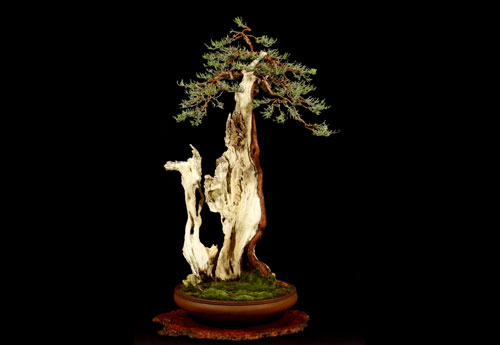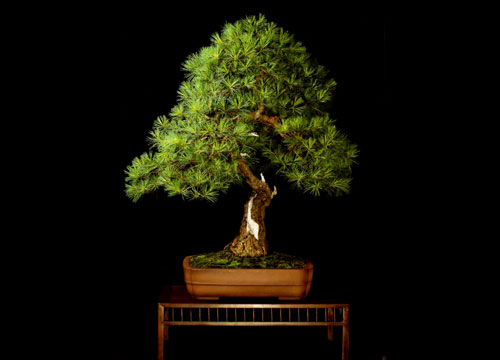
An old Sierra Juniper (Juniperus occidentalis) by John Romano. Height 42″.
In the next few months, Bill Valavanis’ 1st US National Bonsai Exhibition Commemorative Album will be back from the printer and ready for your enjoyment. Meanwhile, there is another very noteworthy book that features some great home grown American (and Canadian) bonsai. It’s the American Bonsai Society‘s North American Bonsai (compiled and edited by Martin Schmalenberg).
When I first saw it, I was impressed with some of the trees but not completely taken by the collection as a whole. I think my bias towards Japanese bonsai clouded my vision. True, many of the trees would never make the cut into most Japanese exhibitions, but maybe that’s not the point. Though we can still learn from the Japanese masters, we don’t need to continually compare our trees with the Japanese, in fact, we do ourselves a disservice when we do.
So, I decided to take a fresh look (in the name of full disclosure, we recently negotiated an agreement with ABS to act as the distributor for the book), and, no matter the motivation, I’m happy I did.
I could say more, but maybe it’s better to let the trees speak for themselves. Here’s a sampling of a couple native American trees to whet your appetite. There are plenty of others that are equally deserving, but we can’t show them all.

A collaboration between nature and human, this twisty bunjin style collected Buttonwood (Conocarpus erectus) shows what can happen when a tenacious tree hangs onto a shoreline that is ravaged by repeated tropical storms and occasional hurricanes. It belongs to Doug Hawley who has been adding his experienced touch for about ten years. Height 28″ Pot by Sara Rayner.

I picked this one for two good reasons. It’s a great old collected tree, with a worthy history, a powerful lower trunk and a distinctive shari. Beyond that, what really got me is that it’s an Eastern White Pine (Pinus strobus). They are the dominant tree around these parts (northern Vermont) and much of the northeastern US and eastern Canada, and yet, I’ve never seen a real quality Eastern White Pine bonsai until now, as their largish needles, long internodes and upright growth habit makes good bonsai stock extremely rare. The tree belongs to Martin Schmalenberg. Height 42″
That’s enough for now. If you are interested, the book is titled North American Bonsai and it’s available through ABS and Stone Lantern and perhaps at your local bonsai nursery.
A pleasure to read. All the good luck with this new feature. Look forward to coming back.
Best regards
Morten Albek
Very inspiring. What next???
Thank you both.
What next??? Well, we’ve got several things in the works, including: an interview with Michael Hagedorn, a foremost American bonsai artist and the author of Post Dated and, more on field growing, particularly soil. And that’s not all…. stay posted.